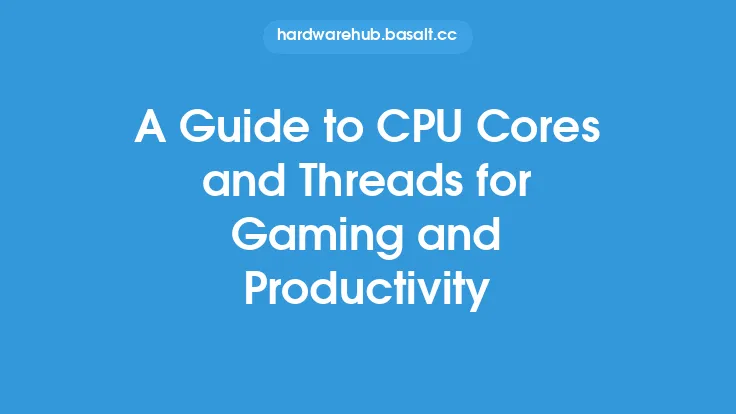When it comes to computer hardware, the central processing unit (CPU) is one of the most critical components. It's responsible for executing instructions and handling tasks, making it the brain of the operation. Within the CPU, there are several key components that work together to get the job done, including CPU cores and threads. In this article, we'll delve into the world of CPU cores and threads, exploring what they are, how they work, and why they're essential for modern computing.
Introduction to CPU Cores
A CPU core is the primary processing unit within a CPU, responsible for executing instructions and handling tasks. It's the core's job to take in instructions, decode them, and then execute them, using a combination of arithmetic logic units (ALUs), registers, and other components. In the past, CPUs had only one core, which limited their ability to multitask and handle multiple instructions simultaneously. However, with the advent of multi-core processors, CPUs can now handle multiple tasks at once, significantly improving performance and efficiency.
Understanding CPU Threads
A CPU thread, on the other hand, is a separate flow of execution within a CPU core. Threads allow a single core to handle multiple tasks simultaneously, improving responsiveness and system performance. Each thread has its own program counter, stack, and local variables, but shares the same memory space and resources as other threads within the core. This allows threads to communicate with each other and share data, making it easier to write efficient and concurrent code. CPU threads are often referred to as "logical processors" or "virtual cores," as they appear as separate processing units to the operating system and applications.
How CPU Cores and Threads Work Together
So, how do CPU cores and threads work together to improve system performance? When a CPU receives an instruction, it's decoded and executed by the core's execution units. If the instruction requires multiple threads to be executed simultaneously, the core will create a new thread and assign it to a available execution unit. This allows the core to handle multiple tasks at once, improving responsiveness and system performance. For example, if you're running a web browser, email client, and word processor simultaneously, each application will be assigned to a separate thread, allowing the CPU to switch between them quickly and efficiently.
Hyper-Threading and Simultaneous Multithreading
Hyper-threading (HT) and simultaneous multithreading (SMT) are technologies that allow a single CPU core to handle multiple threads simultaneously. HT, developed by Intel, allows a single core to handle two threads at once, while SMT, used by AMD and other manufacturers, allows a single core to handle multiple threads simultaneously. These technologies work by duplicating certain core components, such as registers and execution units, allowing multiple threads to be executed simultaneously. This can significantly improve system performance, especially in applications that are heavily multithreaded, such as video editing and 3D modeling.
CPU Core and Thread Count
The number of CPU cores and threads available on a system can vary greatly, depending on the specific processor and system configuration. Most modern CPUs have between 2 and 32 cores, with some high-end servers and workstations having 64 or more cores. The number of threads available on a system is typically twice the number of cores, due to the use of HT and SMT technologies. For example, a quad-core processor with HT might have 8 threads available, while an 8-core processor with SMT might have 16 or 32 threads available.
CPU Architecture and Microarchitecture
The architecture and microarchitecture of a CPU can also impact the performance and efficiency of CPU cores and threads. The architecture refers to the overall design of the CPU, including the number of cores, threads, and execution units. The microarchitecture, on the other hand, refers to the specific implementation of the architecture, including the design of the execution units, caches, and other components. Modern CPU architectures, such as Intel's Core and AMD's Ryzen, use a variety of techniques to improve performance and efficiency, including pipelining, out-of-order execution, and speculative execution.
Conclusion
In conclusion, CPU cores and threads are essential components of modern computing, allowing systems to handle multiple tasks simultaneously and improving responsiveness and system performance. By understanding how CPU cores and threads work together, as well as the technologies that enable them, such as HT and SMT, you can better appreciate the complexity and sophistication of modern computer hardware. Whether you're a beginner or an experienced user, having a solid understanding of CPU cores and threads can help you make informed decisions when it comes to choosing a system or upgrading your existing hardware.





